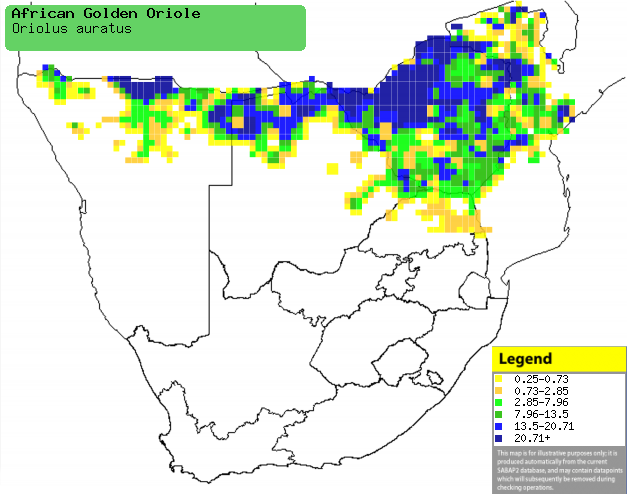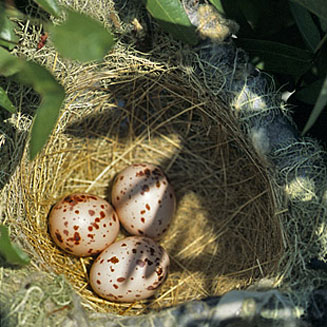|
Oriolus auratus (African golden
oriole)
Afrikaanse wielewaal [Afrikaans]; Isicubujeje [Xhosa];
Nkulivere (generic term for oriole) [Kwangali]; Ndukuzani (generic term for
golden oriole) [Tsonga]; Afrikaanse wielewaal [Dutch]; Loriot doré [French];
Schwarzohrpirol [German]; Papa-figos-africano [Portuguese]
Life
> Eukaryotes >
Opisthokonta
> Metazoa (animals) >
Bilateria >
Deuterostomia > Chordata >
Craniata > Vertebrata (vertebrates) > Gnathostomata (jawed
vertebrates) > Teleostomi (teleost fish) > Osteichthyes (bony fish) > Class:
Sarcopterygii (lobe-finned
fish) > Stegocephalia (terrestrial
vertebrates) > Tetrapoda
(four-legged vertebrates) > Reptiliomorpha > Amniota >
Reptilia (reptiles) >
Romeriida > Diapsida > Archosauromorpha > Archosauria >
Dinosauria
(dinosaurs) > Saurischia > Theropoda (bipedal predatory dinosaurs) >
Coelurosauria > Maniraptora > Aves
(birds) >
Order: Passeriformes > Family: Oriolidae
The African golden oriole occurs in large areas of
sub-Saharan Africa, avoiding lowland forest and arid areas. In southern Africa
it is widespread in the north, preferring miombo (Brachystegia) and
broad-leaved Burkea woodland. It feeds on insects and fruit, mainly foraging
among the tree canopy in mixed species flocks, occasionally coming down to
ground level. The nest is woven cup made of dry grass and plant detritus held
together with spider web, placed between the two branches of a fork, well away
from the tree trunk.
Distribution and habitat
It occupies large areas of sub-Saharan Africa, absent from
lowland forest and arid areas. In southern Africa it is fairly common in
Zimbabwe and northerly Mozambique, Botswana and Namibia, scarce in the Limpopo
Province. It prefers miombo (Brachystegia)
as well as Burkea (Burkea africana) woodland, but it may also move into
more arid savanna and suburban gardens.
|
 |
|
Distribution of African golden oriole in southern Africa,
based on statistical smoothing of the records from first SA Bird Atlas
Project (©
Animal Demography unit, University of
Cape Town; smoothing by Birgit Erni and Francesca Little). Colours range
from dark blue (most common) through to yellow (least common).
See here for the latest distribution
from the SABAP2. |
Food
It feeds on insects and fruit, mainly foraging among the
tree canopy in mixed species flocks, occasionally coming down to ground level.
The following food items have been recorded in its diet:
- Insects
- Fruit
- Euclea (guarris)
- Azadirach indica (alien Neem tree)
Breeding
- The nest is woven cup made of dry grass and plant detritus held together
with spider web, about 8-9 cm wide and 5.0-5.5 cm deep. It is slung between
the two branches of a fork, usually 5-13 metres above ground, well away from
the main trunk of the tree.
 |
|
|
Black-headed oriole nest with eggs, Mutinondo,
Zambia. [photo Warwick Tarboton ©] |
|
- Egg-laying season is from August-January, peaking from
September-November.
- It lays 2-5, usually 2-3 eggs, which in one study were incubated for 17
days.
- The chicks are fed by both parents, leaving the nest after at least 15
days.
Threats
Not threatened.
References
-
Hockey PAR, Dean WRJ and Ryan PG 2005. Roberts
- Birds of southern Africa, VIIth ed. The Trustees of the John Voelcker
Bird Book Fund, Cape Town.
|
